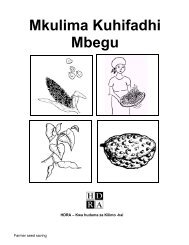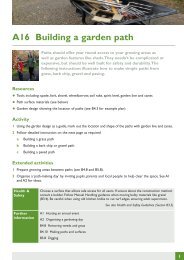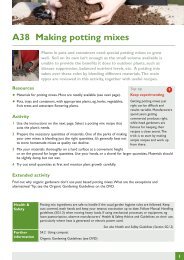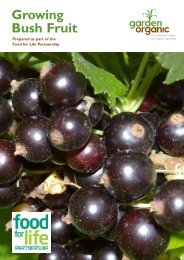Download PDF - Garden Organic
Download PDF - Garden Organic
Download PDF - Garden Organic
You also want an ePaper? Increase the reach of your titles
YUMPU automatically turns print PDFs into web optimized ePapers that Google loves.
http://www.gardenorganic.org.uk/organicweeds<br />
Tillage systems that cause the least soil disturbance have been shown to build-up a<br />
larger and more diverse weed seedbank (Feldman et al., 1997). In a 3-year study in<br />
continuous wheat, conventional tillage with a mouldboard plough gave the lowest<br />
seed density and there was no difference between the 0-5 cm and 5-10 cm layers of<br />
soil. No-tillage gave a denser seed bank especially in the upper layer of soil. Chisel<br />
plough and double-disk harrow systems gave intermediate results. The changes in the<br />
seedbank occurred over a relatively short period of cropping. The build-up of stubble<br />
debris at the soil surface under chisel plough and no-till systems gave shed seeds<br />
some protection from predation. In a 6-year study of cultural practices on weed seed<br />
numbers and distribution in the soil seedbank, there was a greater number of seeds in<br />
the upper 5 cm layer of soil in no-till treatments and fewer under conventional tillage<br />
(Hoffman et al., 1998). In this study, total weed seed number in soil was not<br />
influenced by tillage due to the increased demise of seeds on the soil surface and the<br />
greater persistence of seeds buried by ploughing. However, this was influenced by<br />
the greater seedling emergence under no-till that could potentially result in greater<br />
seed deposition. It is therefore important to prevent seeding in no-till crop<br />
management.<br />
Species that increase vegetatively will also benefit, and there is evidence that<br />
perennial species increase in the absence of cultivations (Froud-Williams et al., 1981;<br />
Cussans, 1976). Common couch (E. repens) is one of the main species to benefit.<br />
Others include onion couch (Arrhenatherum elatius), creeping thistle (Cirsium<br />
arvense), field bindweed (Convolvulus arvensis) and the docks (Rumex spp.).<br />
Biennial species that are normally not adapted to cultivated land may increased if<br />
cultivation is less vigorous. Wind-borne seeds are opportunistic colonisers of reduced<br />
cultivation situations and these also include some perennials for example perennial<br />
sow-thistle (Sonchus arvensis), mugwort (Artemisia vulgaris), coltsfoot (Tussilago<br />
farfara), willow herbs (Epilobium spp.), ragwort (Senecio jacobaea) and dandelion<br />
(Taraxacum spp.). Annual species such as Canadian fleabane (Conyza canadensis),<br />
wild lettuce (Lactuca spp.) and smooth sowthistle (Sonchus oleraceus) can become a<br />
problem (Tuesca et al., 2001). Stubbles left after harvest will attract seed and fruit<br />
eating birds that will increase seed predation but could also increase seed dispersal in<br />
bird droppings. Seedlings of black nightshade and elder for example may become<br />
more common. In reduced cultivation systems, seed shedding by crops at harvest<br />
may result in an increase in volunteer weeds. Many of the current annual weeds were<br />
introduced originally as seed contaminants and are not adapted to dispersal other than<br />
by the action of man, and it is these species that may decline under reduced<br />
cultivations.<br />
References<br />
Ascard J (1993). Soil cultivation in daylight with a light-proof cover on the harrow<br />
reduced weed emergence. Communications 4 th International Conference<br />
IFOAM, Non-chemical weed control, Dijon, France, 221-224.<br />
Ascard J. (1994). Soil cultivation in darkness reduced weed emergence. Acta<br />
Horticulturae 372, Engineering for Reducing Pesticide Consumption &<br />
Operator Hazards, 167-177.<br />
Barnes J P & Putnam A R (1983). Rye residues contribute weed suppression in notillage<br />
cropping systems. Journal of Chemical Ecology 9 (8), 1045-1057.<br />
October 2007 12








